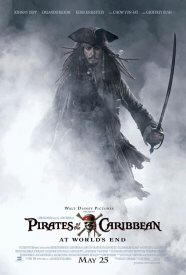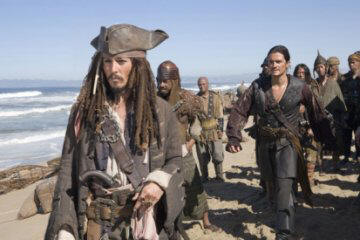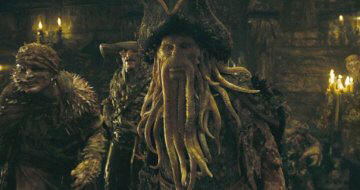|
Pirates Of The Caribbean: At World’s End Reviewed by Rich Drees
Captain Jack Sparrow (Johnny Depp) has been taken to a particular sector of perdition called Davey Jones’ Locker and his friends Will (Orlando Bloom) and Elizabeth (Keira Knightley) enlist the aid of the until-very-recently-deceased Captain Barbossa (Geoffrey Rush) to free Jack in order for him to stop the East Indian Trading Company from eliminating all of the pirates through the manipulation of the squid-faced Davey Jones (Bill Nighy). The crew manages to free Jack from the underworld, but with everybody working for their own agendas, double-crosses abound as the forces of the pirates prepare for a final battle against the East Indian Trading Company for control of the high seas.
In the film’s opening sequence, the East Indian Trading Company is
hanging group after group of pirates while a town crier pronounces
that until the pirate menace has been ended, King George has
suspended the rights of Habeas Corpus, assembly, trial by jury and
others. It would be tempting to read political commentary into the
scene, but the script doesn’t ever reveal any other scenes of sly
intelligence that would suggest the real world parallels are
anything but coincidental. The story charges along pell-mell, from
location to location, often times with no logic to the transitions
therein. Early in the film, the cast set sail from equatorial
Singapore to find passage to Davey Jones’ Locker. A quick edit and
the crew and vessel are in the arctic, fending off the cold. They
sail into what appears to be an ice cave and are suddenly in a more
temperate clime. Granted, these Pirate films are fantasy, but
even fantasy worlds demand a certain logic in order to be
believable.
Additionally, the script takes shortcuts to get the plot to where it needs to be. The kraken, the giant monster devouring Jack Sparrow and the Black Pearl at the end of the last installment, is disposed of by Davey Jones off camera at some point before this chapter opens. As shown, the monster was a powerful force, and its destruction off-screen seems to be a way of removing a powerful obstacle in the way of our heroes so the scriptwriters don’t have to devote any time to resolving that particular plot thread. The script also kills a major supporting character off screen if only to remove the character from an already cluttered story. I’ll assume that that person subsequent appearance while the pirate crew is still in the afterworld of Davey Jones’ Locker was supposed to be a surprise, but the reveal is handled in such a pedestrian manner that it carries not sense of shock. Still the actor does manage to deliver a touching final line, at least giving the scene a small amount of emotional resonance.
With the script attempting to juggle its overabundance of plot
elements, characters and their stories often find themselves shoved
to the background. There are several long sections of the film where
Captain Jack and Davey Jones both seem to be relegated to the status
of supporting characters. One new plot line involves a search for
the sea goddess Calypso, who was once Davey Jones’ lover and had
been imprisoned in human form by a previous grouping of pirate
captains. Unfortunately, for the amount of screen time devoted to
this plot line in both action and exposition, its resolution is so
negligible as to leave one wondering why it was in the screenplay at
all.
While it was his portrayal of the crazed Captain Jack in 2004’s initial Pirates Of The Caribbean film that earned Johnny Depp an Academy Award nomination, here Depp’s work seems a bit unfocused, his grip on the character looser and more cartoonish. There are moments where Jack is hallucinating and Depp’s reactions recall his work as Hunter S. Thompson in Terry Gilliam’s Fear And Loathing In Las Vegas (1998).
Interestingly enough, for a film series well known for its exciting action set pieces, At World’s End, the longest of the three films, only contains two such sequences- the attack on the Singapore pirate hideout by the soldiers of the East Indian Company at the beginning of the film and the large scale battle between the Black Pearl and the Flying Dutchman that climaxes the film. To be sure, the site of the two ships trading broadside cannon blasts while circling a violently swirling whirlpool is impressive and the computer generated imagery utilized here is flawless. Unfortunately, for all its thrills, such a well crafted sequence comes a little too late to save the film from its own flaws. |
 At nearly three hours in length, Pirates Of The Caribbean: At
World’s End is a sprawling, bloated, frenetic mess of a summer
film, desperately trying to manage the many flailing plot threads
left over from the previous summer’s Pirates Of The Caribbean
film, while at the same introducing numerous new ones to the mix.
At nearly three hours in length, Pirates Of The Caribbean: At
World’s End is a sprawling, bloated, frenetic mess of a summer
film, desperately trying to manage the many flailing plot threads
left over from the previous summer’s Pirates Of The Caribbean
film, while at the same introducing numerous new ones to the mix.
